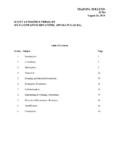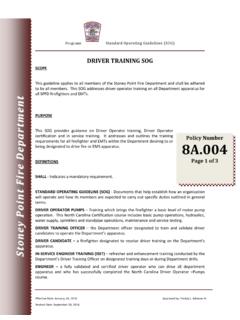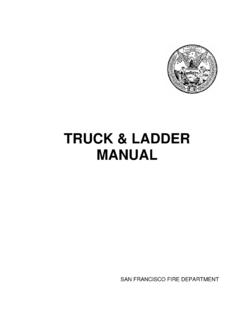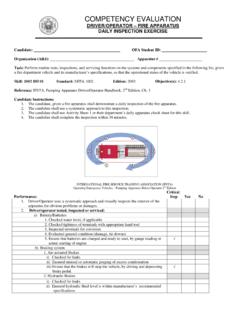Transcription of TRAINING BULLETIN REARMOUNT AERIAL LADDER
1 TRAINING BULLETIN apparatus L-7 May 27, 2010 REARMOUNT AERIAL BULLETIN describes basic operations of the AERIAL LADDER apparatus . Variations ofmodel, year and make may result in differences of the control panels. In addition to this BULLETIN , chauffeurs should refer to the Operation and Maintenance manual for their particular 100 AERIAL LADDER operates by utilizing two double acting hydraulic lift cylinderswhich provide smooth, precise elevation from 0-80 degrees above individually controlled stabilizers can be hydraulically extended out and down toprovide a firm base for AERIAL LADDER capacity varies from 250-750 lbs. at the tip depending on the degree of controls for AERIAL LADDER operations are in three locations: AERIAL Control Panel located in the apparatus Cab - Permits the LADDER Company Chauffeur (LCC) to select the rating mode and engage the front brake lock. Stabilizer Controls located at the Rear of apparatus - Two banks of levers control the extension and retraction of the stabilizers.
2 AERIAL LADDER Controls are located on the apparatus of 100 AERIAL LADDER ApparatusLadder:4 sections; one stationary and 3 sliding sections. The AERIAL LADDER iscontrolled from the rear operated : Length: 36 feetWidth: 8' with stabilizers ' 4" with stabilizers down (5' 2" each side)Height:10' 8"Weight:60,000 lbs. :One on each side near rear wheels of apparatus , operated from controlsin rear apparatus L-7 May 27, 2010 REARMOUNT AERIAL CONTROL PANEL power for operating the ground stabilizers, AERIAL LADDER hoisting, extension androtation is derived from the apparatus engine through a transmission mounted Power Take Off (PTO). Activation of the PTO sends power from the transmission to the hydraulic system instead of the apparatus drive train. (Photo 1)Photo 1 Not Nested LightWhen lit, indicates stabilizers are not completelyretracted into the body for road HourmeterIndicates total hours AERIAL has been System Indicator LightIndicates when hydraulic filter should be LightWhen lit indicates PTO is Control SwitchUsed to start/stop PTO for AERIAL Brake LightWhen lit, indicates front brakes are Brake Lock SwitchUsed to set front wheel brakes during AERIAL ladderoperation (not to be used for parking).
3 Pump LightWhen lit, indicates auxiliary electric hydraulicpump is HydraulicSelects normal PTO pump or auxiliary electricallySwitchoperated Switch and Run LightSwitch to activate generator. Light ON indicatesgenerator has been turned apparatus L-7 May 27, 2010 REARMOUNT AERIAL Power Take Off (PTO) Place automatic transmission in the NEUTRAL (N) position. Engage the MAXI-BRAKE. Move the FRONT BRAKE LOCK SWITCH to the ON position. The FRONT BRAKE LIGHT will illuminate. Open the red cover of the PTO CONTROL SWITCH and flip the switch to the UP position. The PTO LIGHT will illuminate. The apparatus is now in Power Take Off (PTO) The AERIAL LADDER must be bedded and stabilizers fully nested. Store wheel chocks, stabilizer pads, and make sure all compartments doors are closed. Close the red cover of the PTO CONTROL SWITCH, this will toggle the switch DOWN and disengage the PTO. Move the FRONT BRAKE LOCK SWITCH to the OFF Controls - Hydraulically operated H frame stabilizers are located behind therear wheels.
4 The controls for these stabilizers are located at the back of the apparatus in the Stabilizer Control Compartment, one control handle for each stabilizer. The stabilizers each require a clearance of 5 2 for full horizontal extension. The operator can view the stabilizer in motion permitting a one firefighter operation. (Diagram 1)231 Diagram 14 Right Side Shown3 apparatus L-7 May 27, 2010 REARMOUNT AERIAL and Vertical Idle/Emergency Pump Down Indicator LightFUNCTIONC ontrols IN/OUT and UP/DOWN movement of the engine throttle system to increase speed of stabilizer operation when the dash switch is in the NORMAL hydraulic mode. Activates the emergency hydraulic pump for control of stabilizers when the dash selector switch is in the EMERGENCY mode. Overrides normal valve operation to allow for Short-Jack operation (horizontally) of the lit indicates stabilizer has been vertically Diverter Valve - The LCC shall pay special attention to the stability ofapparatus at all times.
5 In order to help safeguard the stability of the apparatus , an Interlock Diverter Valve is in place. The Interlock Diverter Valve (IDV) performs two functions. The IDV directs the flow of hydraulic fluid to power either the stabilizers or the AERIAL LADDER . The stabilizers must have a positive pre-load before the AERIAL can become operational. When the ground stabilizers are loaded vertically, the AERIAL interlock valve opens and allows movement of the AERIAL LADDER . When the LADDER is moved from the cradle, it closes the stabilizer interlock valve and prevents movement of the Overriding any interlock system must only be done when all consideration is taken for the stability of the apparatus and safety of all persons and A properly placed stabilizer will cause a green STABILIZER DOWN light to illuminate in the Stabilizer Control Compartment. When both stabilizers are properly in place, both green lights will be illuminated and a signal is sent to the Interlock Diverter Valve.
6 This signal engages the AERIAL LADDER Controls allowing operation of the AERIAL This valve will not permit operation of the AERIAL LADDER unless the ground stabilizers are properly set. It will also not permit nesting of the ground stabilizers unless the AERIAL is properly Should a function of the Interlock Diverter Valve system fail, the LADDER or stabilizers can be moved by accessing the override controls located in the Interlock Control Compartment at the rear of the apparatus . Overriding the IDV is for EMERGENCY USE ONLY. This action should only be performed if there is a malfunction and an emergency exists. The IC should be immediately notified if the IDV override is apparatus L-7 May 27, 2010 REARMOUNT AERIAL and Lowering the Stabilizers Begin extending and lowering the inboard stabilizer (working side) first. Be sure the area is clear of members, civilians, hose or obstructions. Activate the HIGH IDLE switch to assist in faster operation.
7 Move the STABILIZER CONTROL HANDLE toward the OUT/DOWN position untilthe stabilizer is fully extended horizontally and beginning to lower to the ground. Astabilizer that is not fully extended horizontally is considered Short-Jacked. Pause operation prior to contact with the ground in order to place Ground Stabilizer stabilizer pads must be used at all times to help disperse the weight of theapparatus over a larger area. With pad in place, resume lowering the stabilizer until it reaches the end of its stroke. Ensure that the green STABILIZER DOWN INDICATOR LIGHT is STABILIZER DOWN INDICATOR LIGHTS must be illuminated before theaerial can be operated. Deactivate the HIGH IDLE switch. Before operating the AERIAL LADDER Controls, Manual Safety Pins must be placed inthe highest hole possible in the stabilizers. This will prevent collapse of thestabilizers in the event of a hydraulic fluid leak.(Diagram 2) Repeat above procedure for the outboard stabilizer (non-working side).
8 When the ground is not level and the apparatus is leaning, start with the stabilizer onthe lowest side first (the direction the apparatus is leaning). The low side stabilizer shall be fully extended horizontally and lowered to its maximum. The high side stabilizer shall then be extended as necessary and then lowered to a point that levels the apparatus . Utilize the Inclinometer mounted at the rear of the apparatus to aid in leveling the apparatus (Diagram 3). If the inboard stabilizer (working side) is also the high side, it must be fully extended horizontally and then lowered the distance necessary to level the apparatus for a safe 25 apparatus L-7 May 27, 2010 REARMOUNT AERIAL LADDERD iagram the Stabilizers to the Nested Position With AERIAL LADDER bedded, remove and stow Stabilizer Manual Safety Pins. Activate the HIGH IDLE switch. Move the STABILIZER CONTROL HANDLE to the UP/IN position, until the stabilizer is fully nested. Deactivate the HIGH IDLE switch.
9 Repeat operation on other CONTROL OPERATIONS8910111213146745123 Diagram 46 apparatus L-7 May 27, 2010 REARMOUNT AERIAL LeverControls LADDER extension and LeverControls rotation of the LeverControls LADDER hoisting and Light SwitchesProvides current to the LADDER lighting Pressure GaugeIncreases engine speed allowing for fasteroperation of AERIAL operating pressure of the hydraulic Cylinder Pressure GaugeIndicates hydraulic pressure at the bottom of thehoisting cylinder. Provides indication ofunsupported LADDER Voltage Indicator LightLight indicates a low voltage condition Alignment lightLight indicates the turntable is aligned to theladder cradle for bedding of the AERIAL Rotation Limit Exceeded lightLight indicates when AERIAL LADDER is rotated pastits safe limit when operating on the Short-jackedside or during a mechanical Overload LightLight indicates (and warning horn sounds) whenladder is subjected to an overload Override Rotation LimitWhen activated, overrides the rotation Pump SwitchActivates auxiliary electric hydraulic pump Alignment IndicatorLight indicates when rungs are lined up betweenladder sections when LADDER is ready to Enable Foot SwitchAllows operation of AERIAL control Overload Actuator SwitchControls AERIAL LADDER tip-over alarm Overload Warning HornHorn sounds a warning (and the light comes on)when LADDER is subjected to an overloaded.
10 See Diagram 4 in reference to items 1-17 apparatus L-7 May 27, 2010 REARMOUNT AERIAL Bed LADDER Depress AERIAL ENABLE FOOT SWITCH at the base of the pedestal. Raise LADDER by pulling back slowly on the HOIST/LOWER lever. Release HOIST/LOWER lever when sufficiently LADDER Depress AERIAL ENABLE FOOT SWITCH at the base of the pedestal. Rotate LADDER by moving ROTATION LEVER as required for proper direction. Release ROTATION LEVER when LADDER has reached desired Fly Sections Depress AERIAL ENABLE FOOT SWITCH at the base of the pedestal. Push the EXTENSION/RETRACTION lever to extend to the desired length. Release EXTENSION/RETRACTION lever when LADDER has reached desired length. If possible make sure RUNG ALIGNMENT INDICATOR light is ON before permitting personnel to climb :Always move control levers at a slow deliberate speed to avoid jerky motions andconsequent whip of the LADDER which could cause personal injury or LADDER damage. Turning off the THROTTLE CONTROL SWITCH on the Pedestal Control Panel will reduce pressure in the system and help with feathering the control Footage numbers are located on the base section vertical struts and thecorresponding bright colored vertical strut of the second section.











